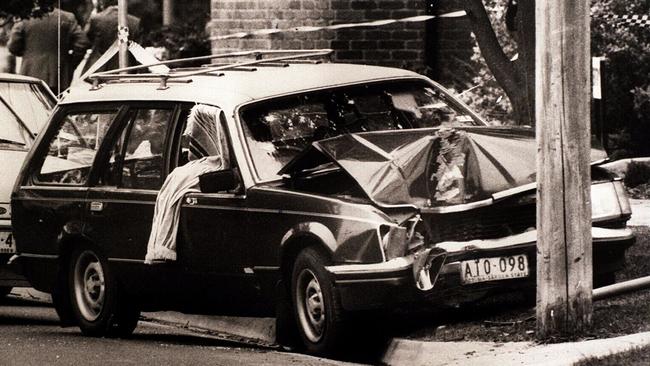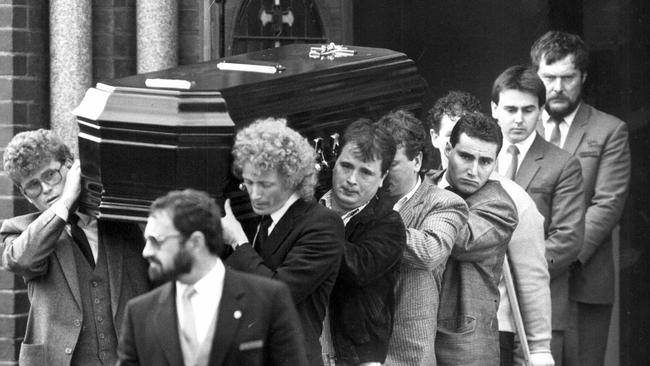Andrew Rule: The cop who saw too many die too young
Ex-cop Joe Noonan has seen enough young dead people to last a few lifetimes — his tough new book is about how violent death deeply affected a lawman.

Andrew Rule
Don't miss out on the headlines from Andrew Rule. Followed categories will be added to My News.
There’s a limit to what former police reveal after they leave “the Job”. Apart from the risk of revealing covert investigation methods, there’s the danger of defaming bent cops and of alienating colleagues and friends.
Two weeks ago, a former elite investigator recorded a long podcast interview with this newspaper about the way crime cartels move millions around the globe. Next day, he got cold feet — or his family did — so we killed the recording.
But another ex-cop has jumped in boots and all with a tough little book based on his time in frontline policing.
Joe Noonan’s book, Breaking Ranks, criticises aspects of the force he served during a lethal decade. Leaving aside wisecracks and ripping yarns about meeting interesting people and handcuffing them, it is about how violent death deeply affected a lawman.
One day in April 1984 Noonan and another detective rushed to the scene of a police shooting to find that a policewoman had tried to shoot a dangerous armed man just as her colleague tackled the offender. The result: a fatally wounded policeman, Neil Clinch.
Young Noonan cradled young Clinch as he died.
“I looked into his eyes and I’d like to think he could hear me and know that he wasn’t alone.”
Underneath the hard bitten humour, Noonan was never quite the same after that.

Noonan was also among the first at the scene at two very different police shootings: those of Walsh St murder suspects Jedd Houghton and Gary Abdallah. These weren’t tragic accidents like the Clinch case.
Noonan and a fellow Major Crime detective were set to raid the heavily-armed Houghton at a Bendigo caravan park when the Special Operations Group arrived and took out the cop killer.
Houghton was seen as a clean kill, more than can be said for Abdallah’s.
Not to mention that of Graeme Jensen, the cocky armed robber whose cards were marked before he was shot dead in Narre Warren in circumstances never satisfactorily explained.
The Jensen shooting, following that of his fellow robber Frank Valastro, triggered the payback murder of young policemen Steve Tynan and Damian Eyre at Walsh St, South Yarra, in late 1988.
The tit-for-tat savagery of Walsh St angered even the underworld, especially because it prompted the crime squads to carry out dozens of raids to put pressure on anyone with information.
Noonan reveals his first hand knowledge of the Abdallah shooting.
At 24, Abdallah was a thief with a vicious streak. He was suspected of supplying a getaway car rather than of the actual shootings. But, after Walsh St, Abdallah was wary, avoided his mother’s Coburg house and lived secretly in a flat at 3/872 Drummond St, Carlton.
Abdallah believed that rogue police were out to kill him, which didn’t stop him deliberately running over Darren Hyde, a policeman’s son, after a drunken clash between Hyde and a female friend of Abdallah’s in the city.

The offence was investigated by a City West detective named Cliff Lockwood, whose main ambition was to join the armed robbery squad.
At a time when trigger-happy police ran hot, he thought he could shoot his way into the coveted squad. Noonan describes Lockwood hanging around the task force like a bikie prospect around Hells Angels, busting to prove himself.
On April 9, 1989, Noonan and two other detectives were transcribing listening device tapes in their office when D24 called to say City West detectives had spotted Abdallah in the Drummond St flat.
Noonan relayed a message from his sergeant to the City West detectives, Lockwood and Dermot Avon: “Do not attempt to arrest Abdallah until we get there.”
It took them less than 10 minutes to get to Carlton but it was too late.
“We walked down the driveway. I saw Sen. Det. Cliff Lockwood walking out of the stairwell …”
As Noonan approached, Lockwood blurted “I shot him” and pointed upstairs. Noonan and his partner ran up and found Abdallah’s bloodied body in a back bedroom with a distressed Dermot Avon trying to resuscitate him.

Avon looked horrified and tearful. Noonan took over working on Abdallah, who had a finger shot off and a bullet wound in the back of his head. Blood and bone matter spattered the room.
Noonan saw a large pistol lying near Abdallah. It turned out to be an imitation, one which a City West sergeant later stated was taken from the station property office, something that got no traction in subsequent court hearings.
Noonan found a pulse. Abdallah was still technically alive when the ambulance took him to hospital, where he would be comatose before dying weeks later.
Noonan dismisses a conspiracy, praising Avon’s sincere attempts to save Abdallah. In the book he carefully presents two contradictory views of what happened but lets the facts speak for themselves. The facts suggest that Lockwood single handedly shot Abdallah and planted the imitation pistol when Avon couldn’t see him.
Years later, post-traumatic stress syndrome hit Noonan. He knows his memory and evidence would be discounted in court if there were a future inquiry.
He recalls finding the only witnesses, two sisters in the flat below. With gentle encouragement, the young women agreed they had heard banging and shouting and a male voice yelling something similar to “Drop the gun”.
Those three very convenient words were vital for the once brilliant defence counsel Robert Richter to get Lockwood acquitted over the shooting five years later.
Lockwood would ultimately leave the force under a cloud and later be sacked from the Northern Territory police before being jailed for drug trafficking.
For Noonan, the first signs of future PTSD showed up the next day. It happened after he instructed two young uniformed constables — much like the murdered pair Damian Eyre and Steve Tynan — to guard the flats overnight in a “divvy van”.
He warned them they could be the target of revenge, as at Walsh St. Noonan and his colleagues worked all night writing statements then returned to the scene at 6am to relieve the van crew.
“What I saw on our arrival still haunts me,” he writes.
“The driver’s window was all the way down, as was the passenger window. Both coppers were slumped in the car and one of their pistols was clearly visible on the dashboard. For one terrifying moment I envisaged we had just walked into another Walsh St murder scene.
“I approached the driver’s side window and had my revolver unclipped and ready. I yelled something … there was no response. I looked more closely and could not see any blood or evidence of a shooting. I reached in and took the revolver off the dashboard. I then saw the other revolver in the centre console of the van. I leaned in … and took that weapon as well. I also removed their portable police radio.”
Noonan and his colleague woke the sleeping pair and Noonan started screaming at them, a barrage that ended with “You could have both been killed with your own guns!”
He was ushered away, shaking with anger, to stop him attacking one of the constables who was stupid enough to argue.
“I had seen enough young dead people to do me for a few lifetimes and I didn’t want to see any more.”





